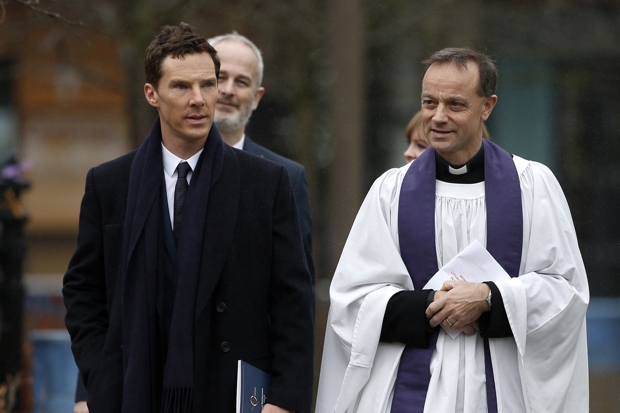Imagine if the body of a notorious child killer was exhumed and that, during the week of its reinterment, 35,000 people thronged the streets of a major UK city to respectfully watch the passing of the specially designed coffin and, with hopeful hurls, bedeck that coffin with white roses. The funeral procession itself is led by two knights in full medieval armour. Then people queue for four hours to file pass the coffin in a cathedral while the prayers of the highest ecclesiastics of the land who officiate over the solemn, ceremonial proceedings are communicated across the country.
Not very likely, is it? Well, that’s what has been happening this week in Leicester. Such is our (and the world’s) preoccupation with British royalty that King Richard III has – some 530 years on – been afforded this singular and somewhat bizarre honour. Of course, the surprisingly fervent and vocal defenders of Richard, who congregate under the respectful and scholarly auspices of the Richard III Society, would acquit him of the crime of murdering his young nephews and (probably) rightful heirs to the throne: the twelve or thirteen-year-old King Edward V and his nine-year-old brother, Richard, Duke of York. Philippa Langley, founder of the ‘Looking for Richard Project’ – and, indeed, finder of Richard’s body in the world’s most famous car park in August 2012 (another first for Leicester) – is the most visible and famous face of Richard’s fan club. On Sunday, David Starkey labelled her ‘a loon of the Richard III Society’. Though somewhat unchivalrous, he has a point: if Richard were alive today no doubt the queues this time would be of women outside his cell on death row proposing marriage to him. He obviously has the appeal of not just being a bad boy, but a royal bad boy.
Pro-Ricardians repeatedly cite the lack of hard proof for Richard killing his nephews in the Tower of London, conveniently ignoring that absence of evidence is not evidence of absence, and, worse still, wilfully ignoring common sense. The murder of the princes in the tower had in all likelihood been committed by October, 1483, four months after Richard had usurped the throne and the time of the Duke of Buckingham’s revolt against the new king. Richard did what any monarch did in his position: kill anyone who had a strong counter-claim to the throne and was thus a figurehead of rebellion. Thus, pace some revisionist claims to the contrary, Edward II was murdered after his deposition; Richard II was killed, probably, starved to death, by Henry IV; and Henry VI was almost certainly killed by Edward IV in the Tower. And, contrary to popular belief, Richard’s victims were not the original princes in the tower: this was the sixteen-year-old Arthur, Duke of Brittany, who also almost certainly killed by his uncle, King John, around 1203. Noticing a pattern here? While the evidence for all these have been buried along with the victims, to think that all the evidence somehow just mysteriously disappeared is to take us into X-Files territory. What was new – and irretrievably damaging to Richard’s reputation and support – was that his victims were blameless children.
It was the same with the judicial killing of the Tudors: Mary had Lady Jane Grey executed only after the Wyatt rebellion threatened to topple her in 1554; and Elizabeth I sent Mary Queen of Scots to the chopping block in 1587 following the Babington plot. As Shakespeare has Richard saying on slaying the Duke of Somerset: ‘Priests pray for enemies, but princes kill’.
Citing all the good things Richard achieved does not mean that bad men can’t do good things. Hell, even Mussolini made the trains run on time; and look what the vegetarian Hitler did for raising the profile of animal rights. And while Richard might have been an early proponent for ‘legal aid’, he simply bypassed the law whenever he found it inconvenient, lopping off the heads of his opponents in a wholly non-judicial manner that makes the royal power struggles in Game of Thrones look like a Nicholas Witchell report on Kate and William at a charity fund raiser.
Is it even Richard that is being buried? Prof Michael Hicks, author of numerous works on fifteenth-century England, is doubtful. If future scientific testing challenges or even overturns the identification of the skeleton in the car park as Richard III, will these poor old bones be dug up yet again and this time be buried in a municipal cemetery? I doubt it. It seems that royalty can literally get away with murder.
The second, expanded edition of Sean McGlynn’s Blood Cries Afar: The Magna Carta Civil War and the Invasion of England, 1215-1217 is out in May.






Comments